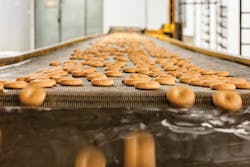Nelson Leite is a business development manager for JMP Solutions – Automation & Robotics Division. In this role, Leite focuses on key industries such as food and beverage and consumer packaged goods. Leite formerly owned his own robotics and automation company, giving him more than 30 years of experience in the automation and robotics realm. He studied mechanical engineering, electrical technologies as well as business through the University of Waterloo, Conestoga College and Wilfried Laurier University.
Q: Which robotics applications are most prevalent in the food and beverage industry?
A: The application that most people associate with robotics in the food and beverage industry is "pick and place," which has been a staple of the food processing industry for years. This application repositions product to desired positions in a production or into a packaging line. Robots speed up the process of food production and can be customized to fit specific assembly requirements. They are also more predictable as their production is consistent, they can run at faster speeds than their human counterparts and their repeatable operation improves quality. All of these factors contribute to a greater production output, not to mention robots take fewer coffee breaks.
Another key application for robotics is clean-in-place (CIP). The same robots that are used for the manufacturing process automatically convert to CIP robots. CIP is a procedure for cleaning equipment surfaces such as process pipes and devices without disassembly. Typical food and beverage applications cleaned using an automated CIP system are product transfer lines, processing tanks, homogenizers, mixers, blenders and fillers. CIP applications use a mix of chemicals, heat and water to clean machinery by circulating detergent, disinfectant solutions and water through the processing equipment. This ensures consistent and high-quality cleaning of equipment surfaces which is critical to food safety.
Q: What are the drivers for food processors to move to more automation in the plant?
A: Labor capacity, reducing turnover and labor savings are the key economic drivers for many companies. Companies are seeking to increase capacity but with the low unemployment rate, particularly in the area of general labor, it becomes difficult to meet the demand for the increased labor making automation more attractive.
Increased minimum wage rates in North America have closed the gap from an ROI perspective improving the cost of return when considering moving to a robotic system.
In addition, cleaning duties on a food line tend to be the toughest positions to fill and keep filled, so robots solve this issue by reducing the turnover and training requirements for these roles.
Food and beverage is one of the fastest-changing industries in business today. Consumers demand products that can be more difficult to process, and companies need to respond with safe, quality goods that are not going to put off the buyer in terms of price. To stay ahead of competition and contribute to the bottom line, companies must remain flexible and diligent in making sure their facility is clean to ensure food safety. Automation can be an advantage for food processors as they change their processing lines, keep ahead of work in process and demand from the supply chain.
Q: Describe some of the benefits food processors can realize in implementing a robotic solution in their processing plant.
A: Robots can increase operational efficiency, throughput and quality, all while protecting employees, the company and maximizing process flexibility.
Robots are being integrated into more processing applications every day to save time and space, as well as to improve cleanliness and safety. They can be the answer for processors who need to increase safety in their operations. And, as government regulations become more stringent and competition intensifies, the need for robots is increased in the industry.
The benefit to processors that use CIP is that the cleaning is faster, less labor-intensive, more repeatable, and poses less of a chemical exposure risk. Another benefit of robots in this application is that processors can deploy a high-speed robotic solution in the plant that picks product by day and self-cleans at night.
Q: Where do robots fit into a company’s food safety procedures?
A: Food processors must pay close attention to basic operational conditions and procedures that are required to ensure food safety within the plant. These include the maintenance of equipment and utensils used within processing, and the use of suitable chemicals within and around the plant including cleaning chemicals, pest control chemicals and machine lubricants, and the cleanliness of the facility, equipment, utensils, floors, walls and ceilings.
Robots have a small footprint, are low in cost and provide high throughput rates, so they can be a valuable addition to this process. By limiting contact with human beings, robots reduce the risk of contamination leading to foodborne illness. In addition, robots can be designed to prevent bacteria, they are easy to clean in high temperatures and they do not collect dust. That means that they can help prevent food contamination.
Q: Where do food and beverage processors start on their automation journey?
A: Processors should take some time to define the outcomes they would like to achieve for their business. Are they looking to increase yield and throughput? What about limit accidents in the plant? Once these questions have been asked and answered, their goals need to be laid out in a project plan. This is an exercise that is best done with a certified robotics/automation integrator that can plan the project for success. Key to this planning is a methodology framework that analyzes the business drivers and lays out the project, change management, risk and quality milestones that the project needs to meet, as well as budget, scope and timeline. The processor needs to understand and agree to all of these steps before they commit to the project.

